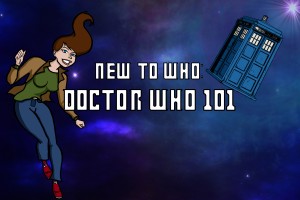
Hello Whovians and welcome to ‘New to Who,’ where I, Hello McFly, will be your guide through Doctor Who. There’s a reason people refer to the show and its ensuing fandom as “the Whoniverse” – between the TV series, movies, books, comics, radio plays, podcasts, merchandise, and a plethora of fan-created material, it’s next to impossible to figure out exactly what it’s all about. Add the fact that the show has had over fifty years to morph and grow, and most will cry uncle. Yet for all of its complexities, the core of Doctor Who is easy to understand. So sharpen your pencils and grab your notepads, because today we’re going through Doctor Who 101.
Back to Basics
Doctor Who is a sci-fi television program created by the BBC that has run since 1963. The show centers around the Doctor – a humanoid time-traveling alien – and his adventures. With his sentient spaceship, he travels through time and space, usually with other people known as “companions.” He goes to different eras and interstellar civilizations, fighting villains and seeking to help others. While predominantly labeled as “sci-fi,” its genres range from action-adventures to horror to comedy.
I’ll be honest, this is an incredibly watered-down explanation of Doctor Who, but it is true to the heart of the show; in its simplest form, it is a sci-fi adventure show that has the freedom and creativity to do anything, and I do mean anything. Wonder if the Doctor meets Queen Nefertiti? He does, which leads to her dating a 20th century British game hunter. Does the Doctor see the mythical Loch Ness Monster? Yep, though it turns out to be a cybernetic reptile controlled by shape-shifting aliens. How about meeting a race of farting aliens trying to take over the world? Bingo, and it’s just as awkward as you’d imagine it to be. Wonderful, weird, other-worldly – Doctor Who brings every possibility alive with its creative premise.
Vocabulary
To traverse the universe of Doctor Who and make sense of its topsy-turvy story, you need to learn the lingo. Granted, there are likely more alien species than there are elements on Earth (Correction: there are definitely more species than Earth elements), but you only need to learn the most basic terms to get the experience.
The Doctor – A time-traveling humanoid alien and the titular character of the show. The Doctor is a member of a race of beings called the Time Lords from the planet Gallifrey. Most Time Lords observe a strict policy of non-interference in the events of the universe, but the Doctor goes rogue by stealing the TARDIS (see below) and intervenes in history in order to fight evil and help others. As a Time Lord, the Doctor can heal himself whenever seriously injured or elderly by changing into another humanoid form, also known as “regeneration.” This creative ability allowed the show to run for over fifty years and feature numerous actors as “The Doctor.”
Companion – A character who travels with or has adventures with the Doctor. The character(s) is a surrogate for the audience, able to ask the Doctor questions and help the audience follow the story. They are typically young people from modern-day Earth, though others have come from Earth’s past and future, and even from other planets. Their story-telling use ranges from causing or being in trouble to saving or helping the Doctor with a means he would not otherwise have. Companions come and go through the series, changing with the times and demands of the audience.
TARDIS – Stands for “Time And Relative Dimension In Space.” It is the sentient time-traveling space the Doctor uses to traverse reality. Disguised as a 1960s British police box, it is famous for being “bigger on the inside.” It is an obsolete model, occasionally resulting in taking the Doctor to times and places he did not want nor anticipate.
Sonic Screwdriver – A multifunctional tool used by the Doctor. Its uses range from lockpicking to scanning to tracking aliens to remotely control other devices. It has been destroyed and redesigned throughout the years with different Doctor incarnations. Its name is derived from the sonic sound it makes and its tool-like capabilities.
Regeneration – The act of undergoing a transformation, gaining a new physical form and a somewhat altered personality. Time Lords (and more specifically the Doctor) regenerate when they become old or injured, hence why the different incarnations of the Doctor are referred to by their generation (i.e. the Ninth Doctor is the character’s Ninth incarnation).
The Takeaway
Do not be intimidated by the massiveness of Doctor Who; in its basic form, it is easy to understand and get into if you have a little help. If you are unsure of where to begin in your journey, I recommend watching the first season of the new Doctor Who series; created in 2005 after a sixteen-year hiatus (with the exception of a charity episode and made-for-TV movie), it introduces the Ninth Doctor and brushes over the basics of the show. Plus, it is widely available: Netflix, iTunes, Amazon, and numerous other sites HBO Max has most or nearly all of the seasons since 2005. Once you’ve watched those and have a basic understanding of the series, you can go back to older episodes and seasons.
Until next time Whovians – time travel responsibly!





